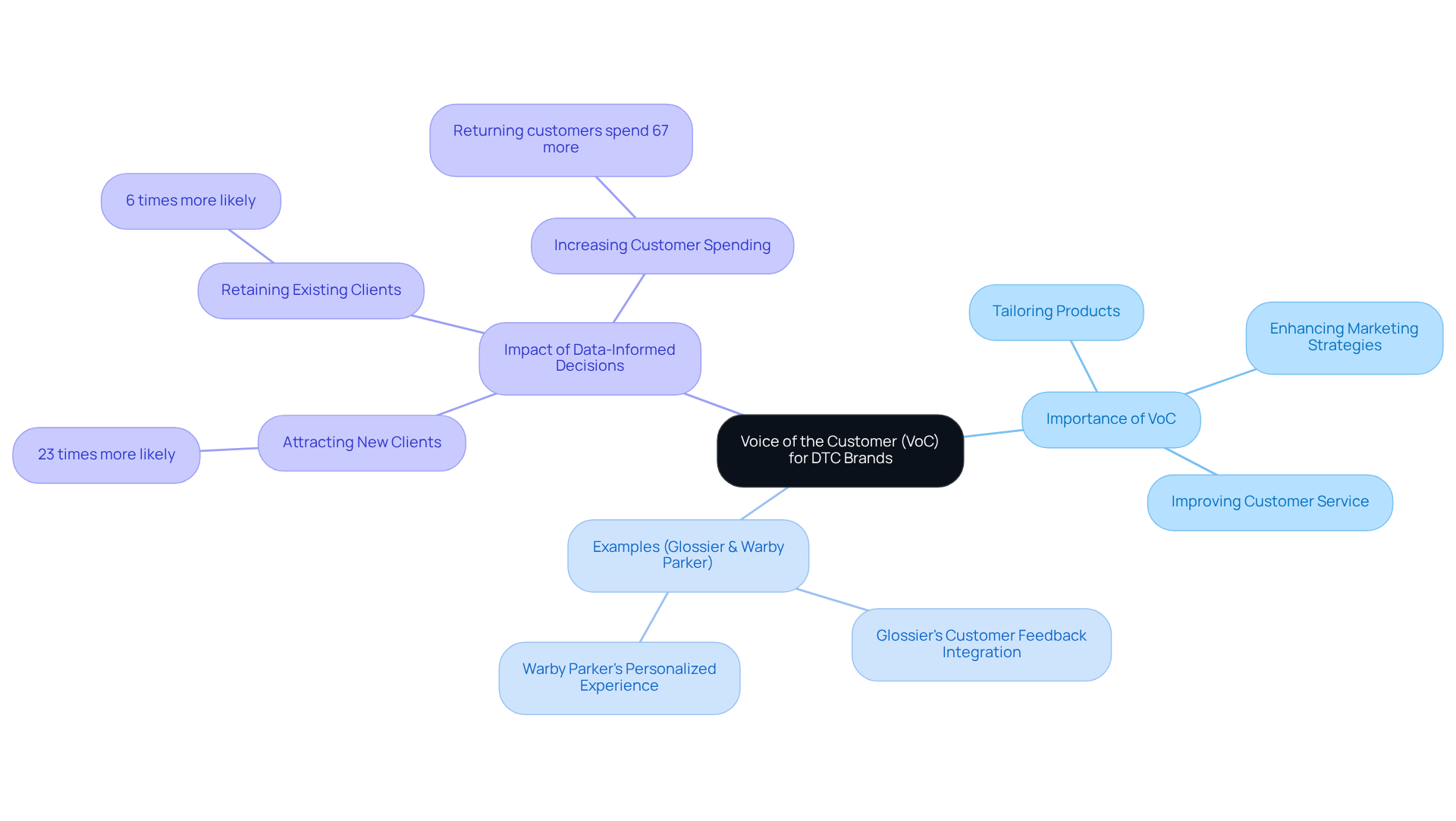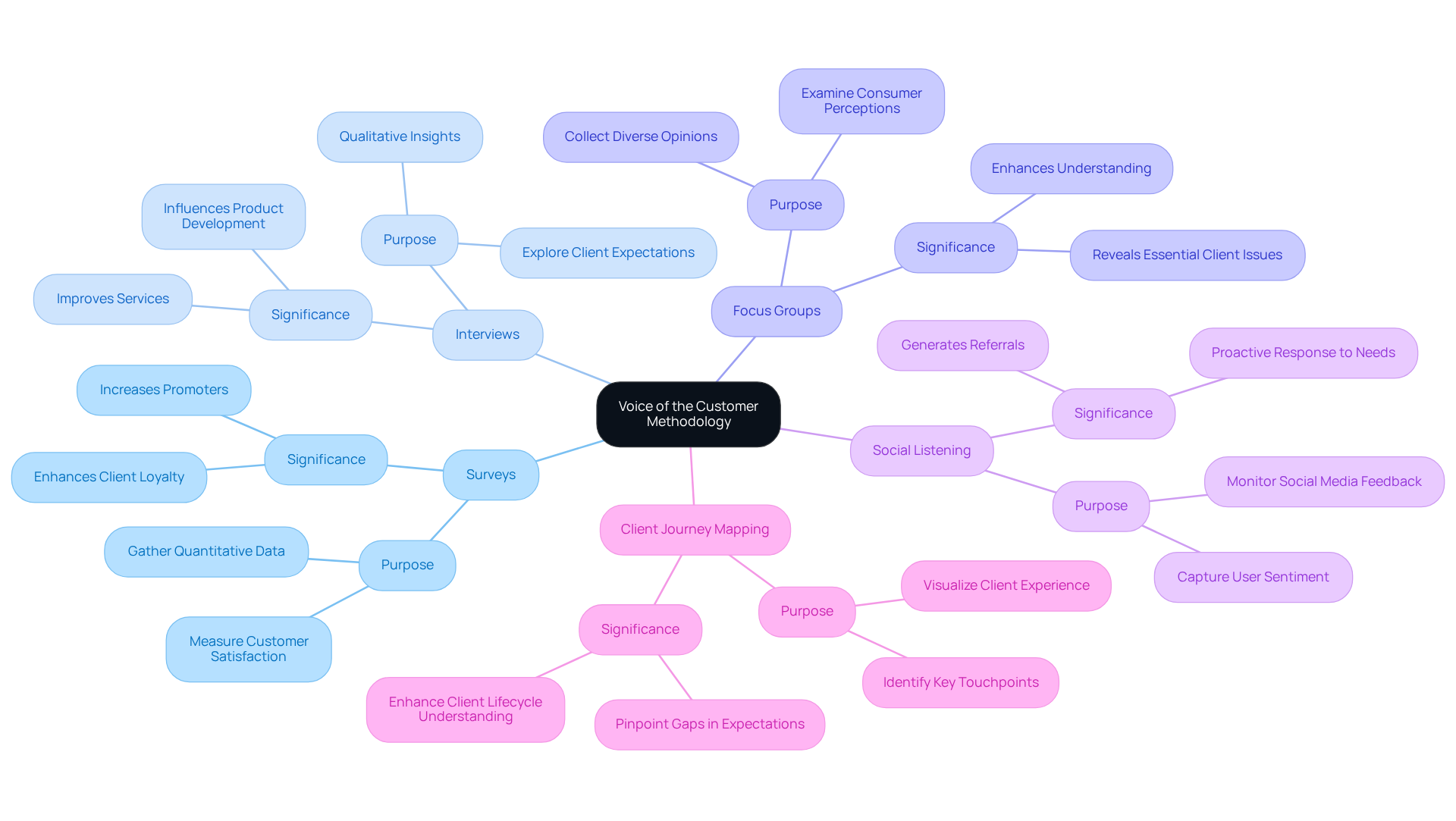
Overview
The voice of the customer (VoC) methodology stands as a cornerstone for direct-to-consumer (DTC) brands. It empowers these companies to capture and analyze customer feedback effectively, which is essential for informed product development and heightened customer satisfaction. By employing techniques such as surveys, interviews, and social listening, DTC brands can cultivate loyalty and drive substantial business outcomes. This includes increased customer retention and revenue growth, ultimately solidifying their competitive edge in the market.
Consider the impact: DTC companies that actively engage with their customers through VoC methodologies not only enhance their product offerings but also create a loyal customer base. The data speaks volumes—brands that prioritize customer feedback see a marked improvement in satisfaction levels, which translates into repeat business and higher profits.
In conclusion, embracing the VoC methodology is not just a strategy; it’s a necessity for DTC brands aiming to thrive in a competitive landscape. By prioritizing customer insights, these companies can ensure they meet and exceed customer expectations, paving the way for sustained growth and success.
Introduction
Understanding customer feedback is essential for brands navigating the competitive landscape of direct-to-consumer (DTC) markets. The voice of the customer (VoC) methodology provides a structured approach that empowers companies to capture and analyze insights directly from their clients. This not only unlocks opportunities for enhanced satisfaction but also fosters loyalty. As consumer expectations evolve, the pressing question arises: how can DTC brands effectively leverage this methodology to not just meet but exceed these demands?
Define Voice of the Customer Methodology
The voice of the customer methodology is a pivotal strategy for capturing and analyzing feedback on customer experiences, expectations, and perceptions regarding a brand's products or services. This structured approach employs a variety of techniques—surveys, interviews, focus groups, and social media monitoring—to gather direct insights from clients. By thoroughly understanding the client's perspective, businesses can identify pain points, preferences, and opportunities for improvement, all of which are essential for boosting client satisfaction and loyalty.
VoC goes beyond simple data collection; it emphasizes the interpretation of this data to guide strategic decisions and drive business growth. Current trends reveal that companies that actively consider client feedback can achieve up to 41% greater revenue growth. This statistic underscores the tangible benefits of a robust VoC strategy. Furthermore, the voice of the customer methodology allows DTC brands to adapt to evolving consumer needs, ensuring they remain competitive in a rapidly changing market landscape.
Tools like Qualtrics XM for Client Experience™ have been recognized as leaders in the Gartner Magic Quadrant, providing effective solutions for collecting and analyzing client responses. Closing the loop with clients after gathering insights is crucial for building trust and engagement, emphasizing the significance of the voice of the customer methodology. By implementing these practices, businesses not only enhance their understanding of client needs but also position themselves for sustained success.

Contextualize VoC for DTC Brands
In the direct-to-consumer (DTC) market, where companies forge direct relationships with their clients, the voice of the customer methodology stands as a cornerstone for success. DTC companies leverage client feedback to carve out a unique position in a competitive landscape, allowing them to tailor products, marketing strategies, and customer service to align with specific consumer needs and preferences.
Take Glossier and Warby Parker, for example. These brands have effectively harnessed the voice of the customer methodology to refine their product offerings and elevate the overall consumer experience. This strategic approach has not only fostered increased loyalty but also driven repeat purchases. Such adaptability, rooted in consumer insights, provides DTC companies with a significant edge in today’s rapidly evolving retail environment.
Moreover, research underscores the critical role of data-informed decision-making: companies that embrace this approach are 23 times more likely to attract new clients and six times more likely to retain them. This statistic highlights how essential client feedback is in cultivating loyalty. As DTC brands continue to prioritize the voice of the customer methodology, they enhance customer satisfaction while solidifying their market position by forging meaningful connections with their audience.

Explore Key Components and Techniques of VoC
Key components of the voice of the customer methodology encompass a range of techniques for effective data collection and analysis. These methods include:
- Surveys: Structured questionnaires designed to gather quantitative data on customer satisfaction and preferences, providing measurable insights into customer experiences. Companies that finalize the process after conducting an NPS survey have been shown to possess three times the number of promoters in later surveys, underscoring the importance of follow-up in enhancing client loyalty.
- Interviews: Comprehensive discussions that yield qualitative insights, allowing brands to delve into client experiences and expectations. This exploration can significantly influence product development and service improvements. As Ian Luck observes, "Voice of client programs must be constructed differently. They should focus on revenue coverage."
- Focus Groups: Facilitated group discussions that examine consumer perceptions and attitudes towards products or services, offering a platform for diverse opinions and collective insights. This method can reveal essential client issues that may not surface through surveys alone.
- Social Listening: The practice of monitoring social media platforms to capture unsolicited feedback and sentiment from users, enabling companies to respond proactively to needs and concerns. Businesses that effectively manage client experience can generate substantial referrals. For instance, SmartBear produced $6 million in referrals through efficient client experience management.
- Client Journey Mapping: A visual representation of the client experience that identifies key touchpoints and areas for enhancement, assisting companies in understanding the complete client lifecycle. This technique is vital for pinpointing gaps between client expectations and reality, as emphasized by Ian Luck's insights on the voice of the customer methodology for gathering and analyzing data.
By incorporating these techniques, DTC companies can cultivate a comprehensive understanding of their clients' needs and preferences. This thorough approach not only enhances client satisfaction but also drives strategic growth, enabling companies to adapt effectively to evolving market demands.

Highlight Importance of VoC for Business Outcomes
The voice of the customer methodology is essential for DTC companies striving to excel in a competitive landscape. A robust VoC program can lead to several significant business outcomes:
- Increased Customer Retention: Actively listening to and addressing customer needs allows brands to foster loyalty and dramatically reduce churn rates. Research indicates that companies leveraging VoC data can achieve up to a 25% increase in client retention. For example, Parah Group's partnership with a $30M clothing line resulted in a remarkable 35% boost in conversion rates, illustrating how understanding client feedback can directly enhance retention.
- Enhanced Product Development: Insights from the voice of the customer methodology drive product innovation, ensuring that new offerings meet client expectations and preferences. Parah Group aided a $15M cleaning product company in refining its products based on consumer insights, resulting in an impressive 80% increase in average order value (AOV).
- Improved Client Experience: By applying the voice of the customer methodology to respond to client feedback, brands can create a more seamless and enjoyable customer journey, significantly increasing overall satisfaction. Companies that prioritize client experience often see a direct link to retention and loyalty. Notably, organizations that set experience objectives grow twice as fast as those that do not. For instance, STRNG Seeds, a cannabis company, improved its bounce rate by 30% through tailored landing pages and the integration of client feedback.
Companies that effectively harness the voice of the customer methodology frequently witness increased sales and profitability, resulting in higher revenue growth. Satisfied clients are not only more likely to make repeat purchases but also to recommend the brand to others, amplifying growth potential. Parah Group's strategies helped a client retain 60% of those at risk of churn and boosted referral revenue by $6 million, highlighting the financial impact of effective VoC strategies.
Brands that have successfully integrated the voice of the customer methodology report substantial revenue increases, underscoring the vital role of understanding client sentiments in achieving sustainable business success. This methodology not only strengthens customer loyalty but also positions brands to thrive amid shifting market dynamics.

Conclusion
The voice of the customer methodology stands as a pivotal framework for direct-to-consumer (DTC) brands, empowering them to effectively capture and analyze client feedback. By honing in on customer experiences, expectations, and perceptions, businesses can extract invaluable insights that inform strategic decisions and ultimately propel growth. This methodology not only elevates customer satisfaction but also positions DTC brands to excel in a competitive landscape by nurturing meaningful connections with their audience.
In this article, we delved into various key components and techniques of the voice of the customer methodology, including:
- Surveys
- Interviews
- Focus groups
- Social listening
Each method offers unique insights that contribute to a holistic understanding of client needs. The significance of actively leveraging this feedback to refine product development, enhance customer experience, and boost retention rates was underscored by compelling statistics and real-world examples, illustrating the tangible benefits of a robust VoC strategy.
Given these insights, it is evident that embracing the voice of the customer methodology is not merely advantageous but essential for DTC brands striving for sustainable success. By prioritizing customer feedback and adapting to shifting market demands, businesses can not only amplify their revenue growth but also cultivate a loyal customer base. As the landscape continues to evolve, harnessing the voice of the customer will be crucial for brands aiming to maintain a competitive edge and foster enduring relationships with their clients.
Frequently Asked Questions
What is the voice of the customer (VoC) methodology?
The voice of the customer methodology is a strategy for capturing and analyzing feedback on customer experiences, expectations, and perceptions regarding a brand's products or services. It employs techniques such as surveys, interviews, focus groups, and social media monitoring to gather insights from clients.
Why is the voice of the customer methodology important for businesses?
It helps businesses identify pain points, preferences, and opportunities for improvement, which are essential for boosting client satisfaction and loyalty. Actively considering client feedback can lead to significant revenue growth.
How does the VoC methodology impact business growth?
Companies that actively consider client feedback can achieve up to 41% greater revenue growth, highlighting the tangible benefits of a robust VoC strategy.
What tools are recommended for implementing the voice of the customer methodology?
Tools like Qualtrics XM for Client Experience™ are recognized as effective solutions for collecting and analyzing client responses.
What is the significance of closing the loop with clients after gathering insights?
Closing the loop with clients is crucial for building trust and engagement, which emphasizes the importance of the voice of the customer methodology in enhancing understanding of client needs.
How does the VoC methodology help DTC brands?
It allows DTC brands to adapt to evolving consumer needs, ensuring they remain competitive in a rapidly changing market landscape.
FAQs











